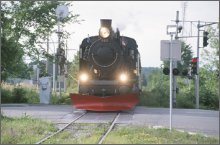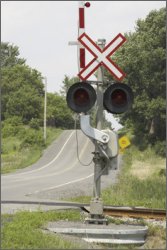Why U.S. Train Intersections are So Dangerous, and How You Can Avoid a Disaster with Trains
by www.SixWise.com
The United States is home to more than 253,000 railroad crossings.
Over 154,000 of these intersect public roads. Trains have
the right of way at crossings -- they can take over 1 mile
to stop -- which means motorists, pedestrians and bikers all
must pay attention to whether a train may be approaching.
|

A train collides with a motor vehicle once every 120
minutes in the United States.
|
Of course, there are safety nets at play -- crossbuck signs,
safety gates, flashing lights. But a surprising number of
crossings have no safety warnings at all, and those that do
may not be effective enough.
Hundreds Die Each Year
A train collides with a motor vehicle about every 120 minutes
in the United States, according to the Wisconsin Department
of Transportation. Because of a train's size and speed, a
motorist is 40 times more likely to die in a crash with a
train, as opposed to a crash with another vehicle.
In 2004 alone, there were 3,045 train-related accidents resulting
in 368 deaths and over 1,070 serious injuries, according to
the Angels on Track Foundation, a non-profit organization
that awards grants to highway authorities for railroad grade
safety upgrades.
The Foundation was founded by Dennis and Vicky Moore after
their 16-year-old son Ryan was killed by a train at a crossing
with no gates, lights or stop signs.
The accidents that occurred in 2004 are typical. There were
similar accidents, deaths and injuries in 2001, 2002 and 2003
as well.
There are railroad crossings in all 49 continental states.
The five states with the most crossings are:
-
Texas
-
Illinois
-
California
-
Kansas
-
Ohio
Seeing how widespread railways are, you may find the following
statistics from the Angels on Track Foundation surprising:
-
About 80 percent of public railroad
crossings have neither lights nor warning gates,
according to the Federal Railroad Administration.
-
About 45 percent of public crossings have crossbucks.
-
Only 23 percent of public crossings have gates (even
though gates have been found to be 80-90 percent more
effective than crossbucks and stop signs).
When asked to testify before the U.S. House of Representatives
Transportation and Infrastructure Committee, Railroad Sub-Committee,
Vicky Moore had this to say:
"The rules need to change. The laws need to change.
There are no federal laws pertaining to sight distance clearance
for public safety. The railroads are responsible for clearing
vegetation from their right of way, 600 feet in both directions
on every public road in the state of Ohio. They're just
words on paper because it's not enforced, and it's not done,
and lives are lost almost every day. Every year, an average
of 300 people are killed at railroad crossings in the United
States. That's almost one every day of every year. Something
has to be done."
Signal Malfunctions Cost Lives
In a computer analysis of government records conducted by
the New York Times, it was found that from 1999 to 2003 there
were "at least 400 grade-crossing
accidents in which signals either did not activate or were
alleged to have malfunctioned."
As a result of these accidents, at least 45 people lost their
lives and another 130 were injured. Railroads have also filed
an additional 2,300 reports since 2000 warning of serious
signal malfunctions such as a short signal or no signal at
all.
Part of the problem may be that, according to Federal rules,
railroads are required to maintain signals on their own tracks
(they're also required to clear vegetation from tracks around
public roads so drivers can see an approaching train).
But whether or not the signals and gates are kept up to par
has some experts worried.
For instance, the Federal Railroad Administration inspected
199 rail crossings maintained by CSX railroad company (prompted
by an accident that occurred because a signal had been out
for maintenance, killing a husband and wife) in 2004.
Nearly half of the crossings had defects. Most were "relatively
minor" but 12 crossings had serious problems.
|

Even if gates are up and warning lights are not flashing,
approach a railroad crossing like any other intersection.
Be cautious and look and listen to determine if a train
is approaching before crossing the tracks.
|
"My concern is that this is just the tip of the iceberg,"
said James E. Hall, a former chairman of the National Transportation
Safety Board. "If we had that type of record in aviation,
it would be unacceptable."
11 Key Safety Tips at Railroad Crossings
Because you can't always count on a warning signal to announce
an oncoming train, you must pay careful attention anytime
you cross railroad tracks. Here are some tips that could,
quite literally, save your life:
-
Expect a train will be coming.
-
Always obey warning signals, lights and gates.
-
When you begin to cross the tracks, make sure there's
room for you to cross completely before having to stop
again.
-
Don't get trapped on the tracks.
-
If your vehicle stalls on the tracks, get out of the
vehicle, move a safe distance away, then call for help.
-
Don't trespass, play or walk near railroad tracks.
-
An oncoming train can be like an optical illusion --
it's nearly impossible to judge its speed or distance
away.
-
Don't try to beat a train across the tracks.
-
Look both ways before crossing -- a train can come from
either direction.
-
You cannot always hear a train coming. If you cannot
clearly see down the track, roll down your window and
listen.
-
Approach every railroad crossing with caution -- don't
assume it will be clear.
Please pass this article on to every vehicle driver (and
bicycle, and pedestrian) you know, ESPECIALLY younger drivers
who are among the leading victims of accidents with trains.
Recommended Reading
The
Six Most Feared but Least Likely Causes of Death
The
6 Most Common Causes of Automobile Crashes
Sources
Angels
on Track Foundation
The
Times-Reporter
The
New York Times: Questions Raised on Signals at Rail Crossings